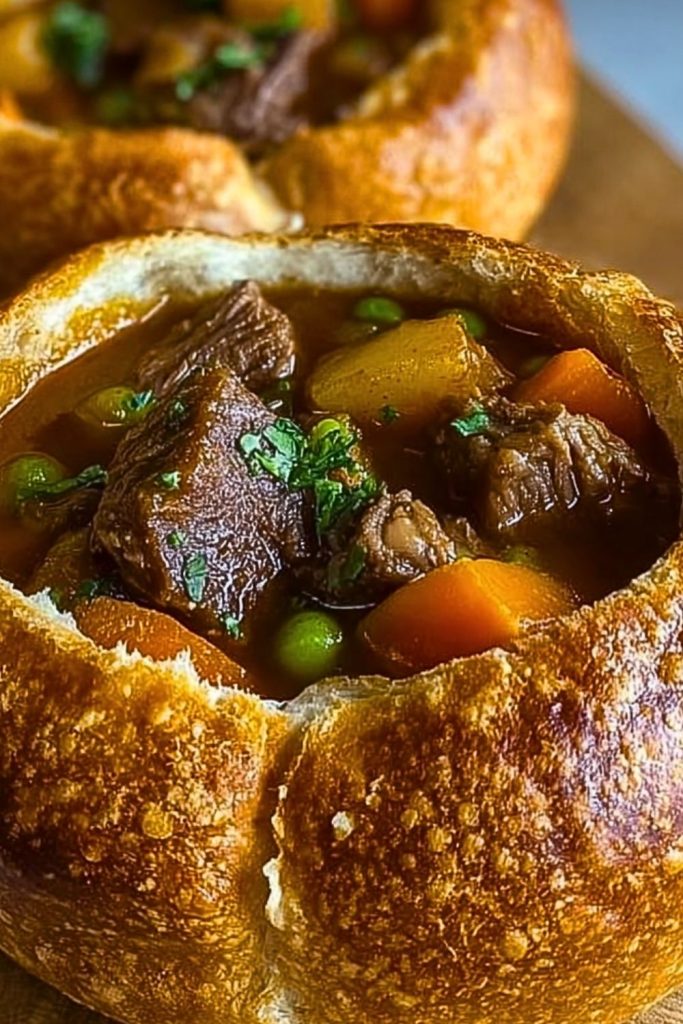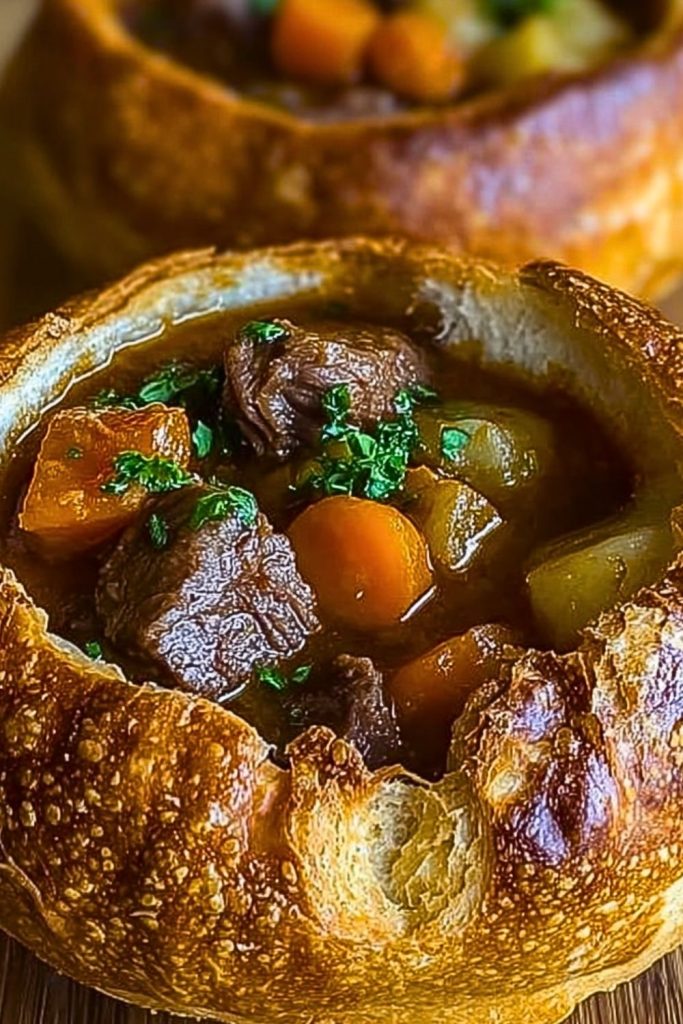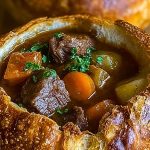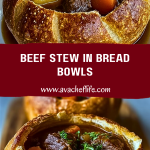When the weather turns chilly and all I want is something hearty and soul-warming, I turn to this Beef Stew in Bread Bowls. It’s the kind of comfort food that wraps around you like a thick blanket — rich, savory, and packed with tender beef, carrots, and potatoes. But what takes this dish over the top is serving it in a warm, crusty bread bowl that soaks up all that incredible flavor. I love how the bread softens just slightly from the stew, becoming part of the experience instead of just a container.

This recipe brings together everything I crave on a lazy weekend or a busy weeknight when I want something extra comforting. The slow-simmered beef becomes melt-in-your-mouth tender, the vegetables soak up the deep flavors of the broth, and that buttery bread bowl? It turns dinner into something a little magical. I’ve served this to guests, and trust me, they never leave a crumb behind.
Why You’ll Love This Beef Stew in Bread Bowls
This isn’t your average beef stew. By serving it in a bread bowl, you’re not only adding a rustic, bakery-style twist, but you’re also turning dinner into an edible experience. The bread absorbs just enough of the stew to become rich and flavorful without falling apart — it’s functional and delicious. Plus, the stew itself is simple but deeply flavorful, thanks to a slow simmer and classic ingredients that come together beautifully. This dish is comforting, impressive, and surprisingly easy to make.
What Kind of Bread Should I Use for Beef Stew in Bread Bowls?
When it comes to bread bowls, sturdiness is key. You want a round loaf with a dense, chewy crust and soft interior that can hold up to a hearty stew without becoming soggy too fast. I usually go for classic sourdough boules because they have that perfect crisp exterior and a slightly tangy flavor that pairs beautifully with the rich beef stew. However, any round artisan loaf or even a small Italian bread round will work. Just avoid anything too soft or airy like sandwich bread — it’ll collapse under the weight of the stew.
Options for Substitutions
Whether you’re working with pantry limitations or dietary needs, this beef stew is flexible enough to accommodate a few swaps:
- Beef: Instead of stew meat or chuck roast, you can use short ribs or even ground beef in a pinch — just adjust the cooking time accordingly.
- Vegetables: No carrots? Try parsnips or turnips. No potatoes? Sweet potatoes or even butternut squash will hold their own.
- Broth: Beef broth adds depth, but vegetable broth or even chicken broth can still work if that’s what you have.
- Flour (for thickening): Gluten-free flour or cornstarch can be used to thicken the stew without wheat.
- Bread Bowl: For a low-carb version, serve it in a roasted acorn squash or just in a bowl with low-carb toast on the side.
Don’t be afraid to play with this — the base flavors are forgiving, and the bread bowl makes everything feel fancy, no matter what tweaks you make.
Ingredients for This Beef Stew in Bread Bowls
Each ingredient in this stew brings depth, texture, or richness — it’s all about building layers of comforting flavor.
- Beef Chuck Roast or Stew Meat: This cut becomes meltingly tender after simmering and gives the stew its rich, meaty flavor.
- Yellow Onion: Adds sweetness and savoriness as the base of the stew.
- Garlic: Brings that essential aromatic depth that makes the broth irresistible.
- Carrots: Their natural sweetness balances the savory broth and adds color and heartiness.
- Baby Potatoes or Yukon Golds: These hold their shape and soak up all that flavor — a must in any classic stew.
- Tomato Paste: Adds umami and gives the broth a rich, slightly tangy backbone.
- Beef Broth: The foundation of the stew; use a good-quality broth for best flavor.
- Red Wine (optional): Adds depth and complexity — it’s subtle, but you’ll notice the difference.
- Bay Leaves: A classic addition for earthy, herbal background notes.
- Thyme (fresh or dried): Adds a woodsy flavor that enhances the beef.
- Worcestershire Sauce: Just a dash boosts the umami and rounds everything out.
- Flour: For thickening the stew to that perfect, spoon-coating consistency.
- Salt and Black Pepper: Essential for seasoning the stew just right.
- Olive Oil or Butter: For searing the beef and sautéing the vegetables.
- Bread Bowls (round sourdough loaves): These transform the stew into something truly cozy and rustic.
Every ingredient earns its place — and once they simmer together, the result is deeply satisfying.

Step 1: Sear the Beef
Start by heating a heavy-bottomed pot or Dutch oven over medium-high heat. Add a drizzle of olive oil or a knob of butter. Once hot, sear the beef chunks in batches — don’t overcrowd the pan. You want a deep brown crust on each piece to lock in flavor. Remove the seared beef and set aside.
Step 2: Sauté the Aromatics
In the same pot, add a bit more oil if needed. Sauté the chopped onion until soft and golden, scraping up the flavorful bits stuck to the bottom. Add the minced garlic and cook for another minute until fragrant.
Step 3: Build the Flavor Base
Stir in tomato paste and cook it out for about 2 minutes. This intensifies the tomato flavor and adds depth. Sprinkle in the flour, stirring to coat the onions and garlic. This will help thicken the stew later.
Step 4: Deglaze and Simmer
Pour in the red wine (if using) and stir well to deglaze the pot. Then add the beef broth, Worcestershire sauce, bay leaves, thyme, and the seared beef back into the pot. Bring to a simmer, then cover and reduce the heat to low. Let it cook for at least 1.5 to 2 hours until the beef is fork-tender.
Step 5: Add Vegetables
Add the carrots and potatoes to the pot. Continue to simmer uncovered for another 30–40 minutes until the vegetables are soft and the stew has thickened. Stir occasionally to prevent sticking.
Step 6: Prepare the Bread Bowls
While the stew finishes, preheat the oven to 350°F (175°C). Cut the tops off your bread rounds and scoop out the inside, leaving about 1 inch of bread along the sides. Warm the bread bowls in the oven for about 10 minutes.
Step 7: Assemble and Serve
Ladle the hot beef stew into the toasted bread bowls. Garnish with freshly chopped parsley or a crack of black pepper if you like. Serve immediately while the bread is warm and the stew is bubbling.
How Long to Cook the Beef Stew in Bread Bowls
This stew isn’t something you want to rush — the magic is in the slow simmer. After searing and building your base, the beef needs at least 1.5 to 2 hours to become truly tender. Then, once you add the vegetables, you’ll need another 30 to 40 minutes to let everything come together. So, you’re looking at a total cook time of around 2 to 2.5 hours. It’s low and slow, but completely worth it for that melt-in-your-mouth texture and rich flavor.
Tips for Perfect Beef Stew in Bread Bowls
- Sear, don’t boil: Browning the beef properly adds incredible depth — don’t skip this step.
- Deglaze with purpose: Whether with wine or broth, scraping up the brown bits is essential flavor-building.
- Simmer low and slow: Keep the heat low once it’s simmering — rushing toughens the meat.
- Use waxy potatoes: They hold their shape better than starchy ones like russets.
- Taste and adjust: Stew is all about balance. Taste before serving and tweak the salt, pepper, or Worcestershire as needed.
- Hollow out bread bowls gently: Leave enough structure so they don’t leak or collapse.
- Warm the bread bowls: This helps keep the stew hot and gives the bread a crisp texture that holds up longer.
Watch Out for These Mistakes While Cooking
Even a cozy dish like beef stew can trip you up if you’re not careful. Here are a few common missteps to avoid:
- Skipping the sear: Browning the beef gives your stew that deep, rich flavor. Tossing raw beef directly into broth will leave you with something bland and flat.
- Overcrowding the pot: If you try to sear too much beef at once, it’ll steam instead of brown. Work in batches — it’s worth the extra time.
- Boiling instead of simmering: High heat will toughen the meat and make your stew greasy. Keep it at a gentle simmer.
- Adding veggies too early: If you throw in the potatoes and carrots at the start, they’ll turn to mush. Wait until the beef is tender first.
- Undercooked flour: Make sure to cook the flour with the tomato paste for a couple minutes — it gets rid of that raw flour taste.
- Using soft bread: A fluffy roll might look cute, but it’ll turn to soup in minutes. Choose a crusty, dense loaf for the bread bowl.
- Serving without resting: Letting the stew sit for 10 minutes before serving helps the flavors settle and intensify.
What to Serve With Beef Stew in Bread Bowls?
Beef stew in bread bowls is already a full, satisfying meal — but if you want to round things out, here are a few tasty additions:
A Simple Green Salad
A fresh, lightly dressed salad with crisp greens balances the richness of the stew.
Roasted Garlic Butter Green Beans
These add a pop of color and flavor without overpowering the dish.
Sharp Cheddar Cheese Plate
A small plate of sliced cheeses and fruit (like apples or grapes) makes a great side snack or appetizer.
A Glass of Red Wine
Pair your meal with a full-bodied red like Cabernet or Syrah to complement the stew’s richness.
Garlic Parmesan Roasted Shrimp
It might sound fancy, but these are quick and provide a contrasting texture to the stew.
A Cozy Dessert Like Bread Pudding
Stick with the comfort theme — warm bread pudding or baked apples are perfect after a hearty stew.
Sparkling Apple Cider
If you’re skipping alcohol, this non-alcoholic drink is festive and flavorful.
Extra Crusty Bread on the Side
Just in case someone finishes their bread bowl and wants more for dipping!
Storage Instructions
If you’ve got leftovers (lucky you!), storing this beef stew is easy — just separate the stew from the bread bowls.
- Stew: Let it cool completely, then transfer to an airtight container. It will keep in the fridge for up to 4 days.
- Freezing: The stew freezes beautifully. Store in a freezer-safe container or zip-top bag for up to 3 months. Thaw in the fridge overnight before reheating.
- Reheating: Warm gently on the stove over medium-low heat or microwave in short bursts, stirring in between. Add a splash of broth or water if it’s too thick.
- Bread Bowls: Unfortunately, bread bowls don’t store well once filled. If unused, wrap them tightly and store at room temperature for 1–2 days or freeze them for longer storage.
Estimated Nutrition (Per Serving Including Bread Bowl)
- Calories: ~580
- Protein: 35g
- Fat: 22g
- Saturated Fat: 8g
- Carbohydrates: 52g
- Fiber: 4g
- Sugar: 5g
- Cholesterol: 95mg
- Sodium: 880mg
Note: Nutrition will vary based on the type of bread and exact quantities used, but this gives you a solid ballpark for a hearty serving.
Frequently Asked Questions
Can I make the beef stew ahead of time?
Absolutely! In fact, beef stew tastes even better the next day after the flavors have had time to develop. Just store it in the fridge and reheat gently when ready to serve.
Can I use a slow cooker for this recipe?
Yes! Sear the beef and sauté the aromatics on the stovetop first, then transfer everything to the slow cooker. Cook on low for 7–8 hours or high for 4–5 hours, adding the vegetables halfway through if possible.
What if I don’t have bread bowls?
No problem. Serve the stew in regular bowls with crusty bread on the side — it’ll still be delicious.
How can I thicken my stew if it’s too thin?
Mix a tablespoon of flour or cornstarch with a splash of cold water and stir it into the simmering stew. Let it cook for 5–10 more minutes until thickened.
Can I make this recipe gluten-free?
Yes! Use gluten-free flour to thicken the stew and skip the bread bowl or use a gluten-free bread alternative.
What’s the best beef to use for stew?
Chuck roast is ideal because it becomes super tender after slow cooking. Stew meat also works well, but avoid lean cuts — they tend to dry out.
How do I keep the bread bowl from getting soggy too fast?
Toast the bread bowl before filling it, and ladle the stew in right before serving to keep it crisp longer.
Can I add more vegetables?
Definitely! Try mushrooms, peas, or celery — just add them at different times depending on how long they need to cook.
Conclusion
Beef Stew in Bread Bowls is the kind of cozy, satisfying meal that warms you from the inside out. It’s rich, savory, and full of tender chunks of beef and vegetables — all tucked into a crusty, golden bread bowl that makes every bite comforting and a little indulgent. Whether you’re cooking for a crowd or just making a special weekend dinner, this recipe is always a hit. Make it once, and it’ll become your go-to whenever you need a bowl (literally) of comfort.

Beef Stew in Bread Bowls
- Prep Time: 20 minutes
- Cook Time: 2 hours 30 minutes
- Total Time: 2 hours 50 minutes
- Yield: 4 servings
- Category: Main Dish
- Method: Stovetop
- Cuisine: American Comfort Food
Description
Crusty, golden, and packed with comforting flavor, this Beef Stew in Bread Bowls is the ultimate cozy dinner idea. Slow-simmered beef, tender potatoes, carrots, and aromatic herbs come together in a rich, savory broth — all served inside a warm, edible sourdough bread bowl. It’s the perfect cold-weather meal and a standout among easy dinner recipes, quick comfort food, or even fun food ideas for hosting. This easy recipe also makes a great weekend project, with hearty results you can enjoy all week. Whether you’re looking for a quick breakfast-style twist or a healthy snack to fill you up, this rustic dish has it all.
Ingredients
450g beef chuck roast, cubed
1 tablespoon olive oil
1 medium yellow onion, chopped
3 cloves garlic, minced
2 tablespoons tomato paste
2 tablespoons all-purpose flour
120ml red wine (optional)
700ml beef broth
1 tablespoon Worcestershire sauce
2 bay leaves
1 teaspoon dried thyme (or 1 tablespoon fresh)
2 large carrots, sliced
300g baby potatoes, halved
Salt, to taste
Black pepper, to taste
4 sourdough bread bowls
Instructions
1. Heat olive oil in a large pot over medium-high heat. Sear the beef chunks in batches until browned on all sides. Remove and set aside.
2. In the same pot, sauté the onion until golden. Add garlic and cook for 1 minute.
3. Stir in tomato paste and cook for 2 minutes. Add flour and stir until combined.
4. Deglaze with red wine (if using), scraping up any browned bits.
5. Pour in beef broth and Worcestershire sauce. Add bay leaves, thyme, and the seared beef. Bring to a simmer.
6. Cover and cook on low heat for 1.5 to 2 hours, until the beef is tender.
7. Add carrots and potatoes. Simmer uncovered for 30–40 minutes, until vegetables are soft and stew has thickened.
8. Preheat oven to 350°F (175°C). Cut tops off bread bowls and hollow out centers.
9. Toast bread bowls in the oven for 10 minutes.
10. Remove bay leaves from the stew, taste, and adjust seasoning with salt and pepper.
11. Ladle stew into toasted bread bowls and serve hot.
Notes
Use crusty, dense bread bowls like sourdough to avoid sogginess.
To save time, prep your vegetables while the beef is simmering.
Leftover stew can be frozen, but don’t freeze the bread bowls — use fresh when serving.
Nutrition
- Serving Size: 1 filled bread bowl
- Calories: 580
- Sugar: 5g
- Sodium: 880mg
- Fat: 22g
- Saturated Fat: 8g
- Unsaturated Fat: 12g
- Trans Fat: 0g
- Carbohydrates: 52g
- Fiber: 4g
- Protein: 35g
- Cholesterol: 95mg
Keywords: beef stew, bread bowl, hearty stew, comfort food, easy dinner

